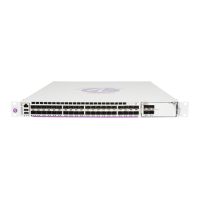Configuring Route Policies
414 7705 SAR OS Router Configuration Guide
If a default action is defined for one or more of the configured route policies, then the default
action is handled as follows.
• The default action can be set to all available action states, including accept, reject,
next-entry, and next-policy.
• If the action states accept or reject, the policy evaluation terminates and the
appropriate result is returned.
• If a default action is defined and no matches occurred with the entries in the policy,
the default action is used.
• If a default action is defined and one or more matches occurred with the entries of the
policy, the default action is not used.
Denied IP Prefixes
The following IP address prefixes are not allowed by the routing protocols and the Route
Table Manager and are not populated within the forwarding table:
• 0.0.0.0/8 or longer
• 127.0.0.0/8 or longer
• 224.0.0.0/4 or longer
• 240.0.0.0/4 or longer
Any other prefixes that need to be filtered can be filtered explicitly using route policies.
Controlling Route Flapping
Route flapping is defined as recurring changes of an advertised route between nodes. That is,
the advertised route alternates (flaps) back and forth between two paths. This is typically
caused by network problems that cause intermittent route failures. Route flap is defined in
RFC 2439.
Route damping is a controlled acceptance of unstable routes from BGP peers so that any
ripple effect caused by route flapping across BGP AS border routers is minimized. The
rationale is to delay the use of unstable routes (flapping routes) to forward data and
advertisements until the route stabilizes.

